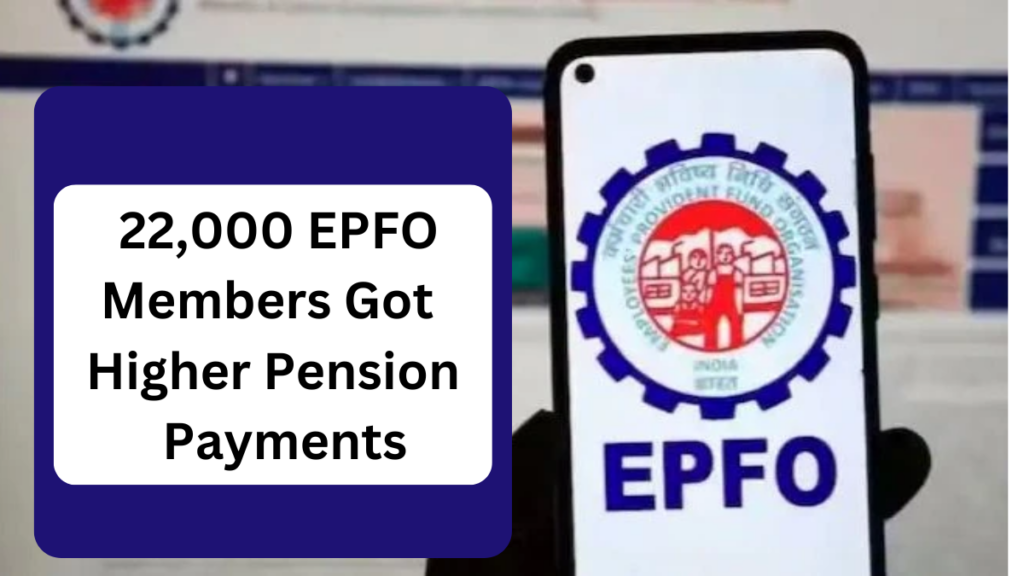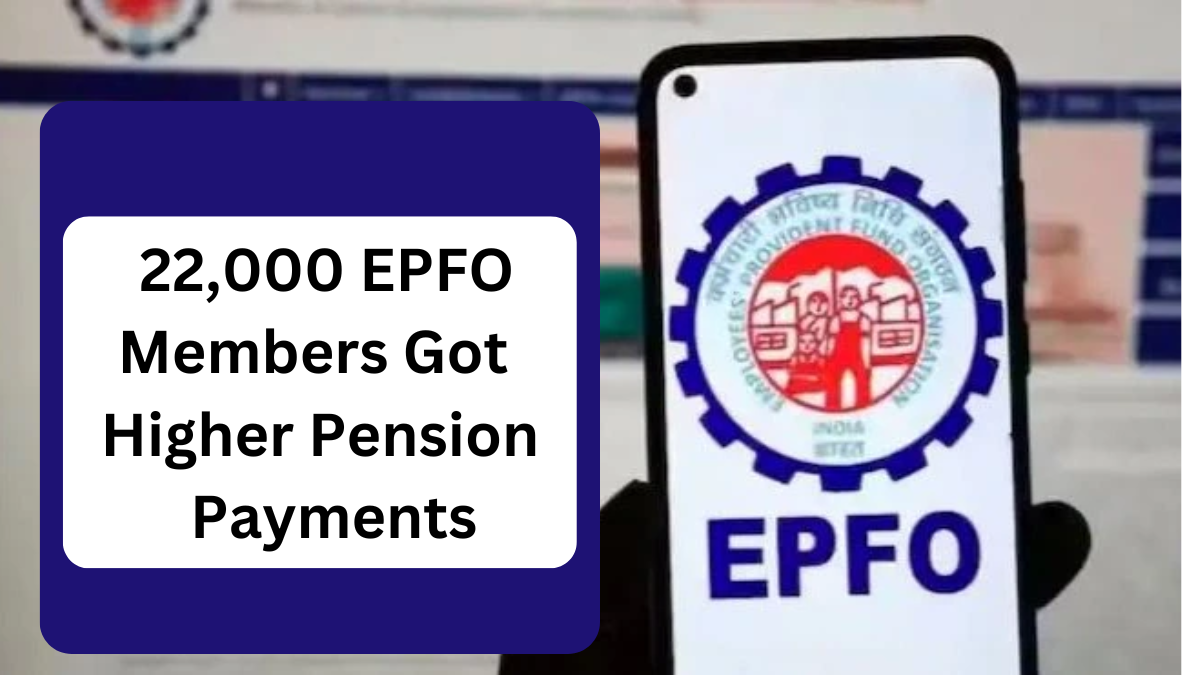The Employees’ Provident Fund Organisation (EPFO) has taken significant strides in implementing the Supreme Court’s directive related to the provision of higher pension benefits under the Employees’ Pension Scheme (EPS), 1995. As of now, over 22,000 members have received their revised pension payouts under the scheme, while approximately 1.65 lakh members have been issued notices to deposit additional contributions to become eligible.
This article provides a comprehensive overview of the scheme, the impact on pensioners, the procedural updates by EPFO, and what employees need to know moving forward.

Overview: What Is the Higher Pension Scheme Under EPS?
Introduced in 1995, the Employees’ Pension Scheme (EPS) is a retirement benefit scheme designed for employees who contribute to the Employees’ Provident Fund (EPF). The standard pension benefits under EPS are based on a contribution of 8.33% of the employee’s salary, up to a cap of ₹15,000.
However, following a Supreme Court judgment dated November 4, 2022, eligible employees can now opt for higher pension payouts by contributing a percentage of their actual salary (not just the capped amount). This change allows employees to align their pension benefits more closely with their real income during their service period.
Key Features of the Higher Pension Option:
-
Applicable to employees contributing to the EPF.
-
Requires joint application with the employer.
-
Employees must contribute more than the statutory cap for higher pension eligibility.
-
Retrospective contributions may be necessary based on salary history.
Recent Developments and EPFO’s Progress
EPFO has actively facilitated the transition by introducing digital services and issuing clear procedural guidelines. Below is a snapshot of the key updates:
Current Progress as Reported in Parliament:
| Particulars | Status/Number |
|---|---|
| Total applications received | 17.48 lakh members and pensioners |
| Higher pension payments disbursed | 21,885 members |
| Members notified for additional contributions | 1,65,621 individuals |
| Latest deadline for joint applications submission | January 31, 2025 |
These numbers reflect the growing interest and participation among EPF subscribers, especially those nearing retirement or already retired and seeking improved financial support.
Key Deadlines and Timeline
EPFO has revised the application deadlines multiple times to accommodate both employees and employers. The latest official schedule is as follows:
| Event/Stage | Deadline |
|---|---|
| Online facility launched | February 26, 2023 |
| Original deadline for joint applications | July 11, 2023 |
| First extension for employer submission | September 30, 2023 |
| Second extension for employer submission | May 31, 2024 |
| Final extended deadline | January 31, 2025 |
EPFO’s Implementation Strategy
To ensure smooth execution of the higher pension scheme, EPFO has implemented a robust monitoring and support system, including:
-
Dedicated online functionality for submitting and tracking higher pension applications.
-
Issuance of detailed clarification letters to field offices for consistent implementation.
-
Timely deadline extensions to provide sufficient time to all eligible members and employers.
-
Issuance of demand notices to members who are required to contribute additional funds for eligibility.
This structured approach ensures minimal disruption and maximum outreach across the country.
Understanding the Need for Additional Contributions
Many applicants for the higher pension scheme had not previously contributed based on their full salary (above ₹15,000) as the EPS capped the pensionable salary at that threshold.
Why Additional Payment is Required:
-
Pension benefits under EPS are calculated on pensionable salary.
-
Employees who want pension based on their full earnings must pay the shortfall, retrospectively.
-
The contribution difference is computed based on years of service, salary details, and the EPFO’s internal calculations.
This may mean a significant one-time payment, but it ensures a notably higher pension amount post-retirement.
How to Check Eligibility and Application Status?
EPFO has simplified the process to verify eligibility and track application status. Members can follow these steps:
-
Visit the official EPFO website: www.epfindia.gov.in
-
Log in with your Universal Account Number (UAN) and password.
-
Click on the ‘Pension on Higher Wages’ section.
-
Check the status of your application or demand notice.
-
If a demand notice has been issued, make the required contribution through the designated EPFO portal.
This platform ensures transparency and easy access for all stakeholders.
Impact on Retired and Retiring Employees
The higher pension scheme presents both opportunities and financial responsibilities. Here’s a balanced view:
Benefits:
-
Higher monthly pension post-retirement
-
Increased financial independence
-
Long-term security, especially for private-sector retirees
Considerations:
-
A large one-time financial contribution may be required
-
Not all applicants may find the benefit outweighs the cost
-
Financial planning and employer cooperation are necessary
For example, an employee who has earned ₹50,000 per month and has been contributing only based on ₹15,000 may now need to contribute the difference for all prior years, resulting in a lump-sum payment. However, this will translate into a significantly higher lifelong pension payout.
Frequently Asked Questions (FAQs)
1. What is the EPS 1995 higher pension scheme?
The EPS 1995 higher pension scheme allows eligible employees to receive a pension based on their actual salary instead of the capped limit of ₹15,000 by making additional contributions.
2. Who is eligible for the higher pension benefit?
Employees who were EPF members before September 1, 2014, and opted for contributions based on their full salary with employer consent, or those who now want to contribute retrospectively, are eligible—subject to EPFO approval.
3. How do I know if I need to make additional contributions?
EPFO issues demand notices to members who have applied but did not contribute the full amount historically. These notices provide the exact amount required and how to deposit it.
4. What happens if I miss the final deadline of January 31, 2025?
If you fail to submit your joint application or required contribution by the final deadline, you may lose the opportunity to receive a higher pension based on actual wages.
Conclusion
The EPFO’s move to implement the Supreme Court’s directive on higher pension marks a pivotal moment in India’s retirement benefits landscape. With over 17 lakh applications already submitted and thousands of members receiving revised pensions, the initiative is gaining traction. However, the process involves careful evaluation, coordination with employers, and financial planning for additional contributions.
Employees planning to enhance their retirement benefits should act promptly. The January 31, 2025 deadline is the final window for joint application submissions. If you believe you’re eligible, now is the time to check your status and make an informed decision.
Click here to learn more
Pari is a passionate writer known for captivating stories that blend imagination and reality. Inspired by travel, history, and everyday moments, Pari crafts narratives that resonate deeply with readers.
